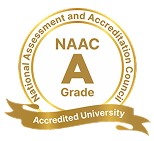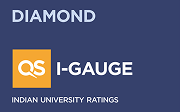OPEN HOUSE 2026 Click here to know more

OPEN HOUSE 2026 Click here to know more

ADMISSION ENQUIRY - 2026
Material Science
|
GANPAT UNIVERSITY |
||||||||||||
|
FACULTY OF ENGINEERING & TECHNOLOGY |
||||||||||||
|
Programme |
Master of Technology |
Branch/Spec. |
Mechanical Engineering/ CAD/CAM/AMS |
|||||||||
|
Semester |
I |
Version |
2.0.0.0 |
|||||||||
|
Effective from Academic Year |
2021-22 |
Effective for the batch Admitted in |
July 2021 |
|||||||||
|
Subject code |
3ME1101 |
Subject Name |
Material Science |
|||||||||
|
Teaching scheme |
Examination scheme (Marks) |
|||||||||||
|
(Per week) |
Lecture(DT) |
Practical(Lab.) |
Total |
CE |
SEE |
Total |
||||||
|
L |
TU |
P |
TW |
|||||||||
|
Credit |
3 |
0 |
0 |
0 |
3 |
Theory |
40 |
60 |
100 |
|||
|
Hours |
3 |
0 |
0 |
0 |
3 |
Practical |
0 |
0 |
0 |
|||
|
Pre-requisites: |
||||||||||||
|
Fundamentals of Materials Science and Metallurgy |
||||||||||||
|
Course Objective: |
||||||||||||
|
||||||||||||
|
Theory syllabus |
||||||||||||
|
Unit |
Content |
Hrs |
||||||||||
|
1 |
CRYSTAL IMPERFECTION: Introduction, Classification of crystal imperfection, Point imperfection, dislocations, and properties of dislocation, surface imperfection, Effect of imperfections on metal properties. |
4 |
||||||||||
|
2 |
PHASE TRANSFORMATIONS AND STRENGTHENING MECHANISMS: Concepts of phase diagrams – phase transformations – significance of phase transformations – thermodynamic aspects of phase transformation-applications, strengthening mechanisms-solid solution hardening-precipitation hardening-grain refinement hardening-dispersion strengthening-bainitic and martensitic transformations. |
6 |
||||||||||
|
3 |
FRACTURE: Ductile fracture, brittle fracture, fracture toughness, ductile transition, mechanism of fracture. |
4 |
||||||||||
|
4 |
CREEP: High temperature material, creep curve, stress-rupture test, deformation at elevated temperature, fracture at elevated temperature, high temperature alloys, effect of metallurgical variable creep under combined stresses. |
6 |
||||||||||
|
5 |
FATIGUE: Introduction, stress cycle, the S-N curve, theories of fatigue, effect of stress concentration on fatigue, size effect, surface finish effect and fatigue, corrosion fatigue, effect of metallurgical variable on fatigue, effect of temperature on fatigue. |
6 |
||||||||||
|
6 |
CORROSION & CORROSION CONTROL: Electrochemical and thermodynamics principles-Nernst equation and electrode potential of metals, standard electrodes and reference electrodes, E.M.F and galvanic series, effect of current density, polarization, Forms of corrosion-Atmospheric, pitting, stress corrosion cracking, intergrannular corrosion, corrosion fatigue, fretting corrosion, high temperature oxidation, crevice corrosion. Corrosion prevention by design improvement, coatings, cathodic and anodic protection, corrosion inhibitors. |
6 |
|
|
7 |
CERAMIC MATERIALS: Classification, Structure of ceramics, properties of ceramics, processing of ceramics, and discussion on specific ceramic materials |
4 |
|
|
8 |
POLYMERIC MATERIALS: Introduction – as a material, Classification – types of polymerization, Mechanisms, Properties of polymers, properties of polymers, processing and application of polymers. |
4 |
|
|
9 |
FUNDAMENTAL ASPECTS OF COMPOSITE: Introduction, classification of composites, historical background – micro – mechanics, inter- phase bond, stress distribution and load transfer, prediction of strength of composites, anisotropy and failure criteria; reinforcement materials, whiskers, inorganic fibbers, metal fibbers, glass fibbers, resins, pultrusion process, structural composites. |
6 |
|
|
10 |
RECENT DEVELOPMENT: Carbonaceous materials – including nano tubes and fullerenes: shape memory alloys, functionally gradient materials; high temperature super conductors; bio materials – concept of bio compatibility – assessment – specific examples – bio electrodes, synthesis, characterization and applications of nano materials. |
4 |
|
|
11 |
TESTING OF MATERIALS: Destructive and non-destructive testing methods. |
4 |
|
|
Practical content |
|||
|
Text Books |
|||
|
1 |
Dieter G.E., „Mechanical Metallurgy‟ 3rd Edition, Mc Graw Hill, 1988. |
||
|
2 |
Dr.O.P.Khanna, “Material science and metallurgy”, Dhanpat rai publications (P) Ltd. |
||
|
Reference Books |
|||
|
1 |
Reed-Hill R.E, „Physical Metallurgy Principles‟, Affiliated East-West Press, 1977. |
||
|
2 |
Avner S.H., „Introduction to Physical Metallurgy‟, 2nd Edition, Mc Graw Hill, 1985. |
||
|
3 |
Raghavan V, „Physical Metallurgy‟, Prentice-Hall of India, 1985. |
||
|
4 |
Fontana M. G, Greene N. D, „Corrosion Engineering‟, 2nd Edition, McGraw Hill, 1978. |
||
|
5 |
Hertzberg R. W, „Deformation and Fracture Mechanics of Engineering Materials‟, 4th Edition, John Wiley, 1996. |
||
|
6 |
Courtney T.H, „Mechanical Behaviors of Materials‟, McGraw Hill, 1990. |
||
|
7 |
Van Vlack, L.H, „Physical Ceramics for Engineers‟, Addison Wesley, 1964. |
||
|
Mooc Links: |
|||
|
1 |
|||
|
2 |
https://nptel.ac.in/courses/113/104/113104096/-Properties of Material |
||
|
3 |
https://nptel.ac.in/courses/113/106/113106093/-Nano Technology |
||
|
4 |
|||
|
5 |
https://nptel.ac.in/courses/112/106/112106293/-Material Science |
||
|
6 |
|||
|
Course Outcomes: |
|||||||||||
|
After learning this course, the student would be able to:
|
|||||||||||
|
Mapping of CO and PO: |
|||||||||||
|
COs |
PO1 |
PO2 |
PO3 |
PO4 |
PO5 |
PO6 PO7 PO8 PO9 PO10 |
PO11 |
PO12 |
PSO1 |
PSO2 |
PSO3 |
|
CO1 |
3 |
1 |
0 |
0 |
0 |
0 0 0 0 0 |
0 |
1 |
2 |
0 |
0 |
|
CO2 |
3 |
2 |
1 |
2 |
0 |
0 0 0 1 0 |
2 |
0 |
2 |
0 |
2 |
|
CO3 |
3 |
2 |
0 |
0 |
0 |
0 0 0 0 0 |
0 |
1 |
2 |
0 |
3 |
|
CO4 |
3 |
2 |
2 |
0 |
1 |
0 0 1 2 0 |
0 |
2 |
2 |
0 |
3 |
|
CO5 |
3 |
2 |
1 |
0 |
2 |
0 0 2 0 0 |
2 |
1 |
3 |
0 |
2 |






